| 2025 |
|---|
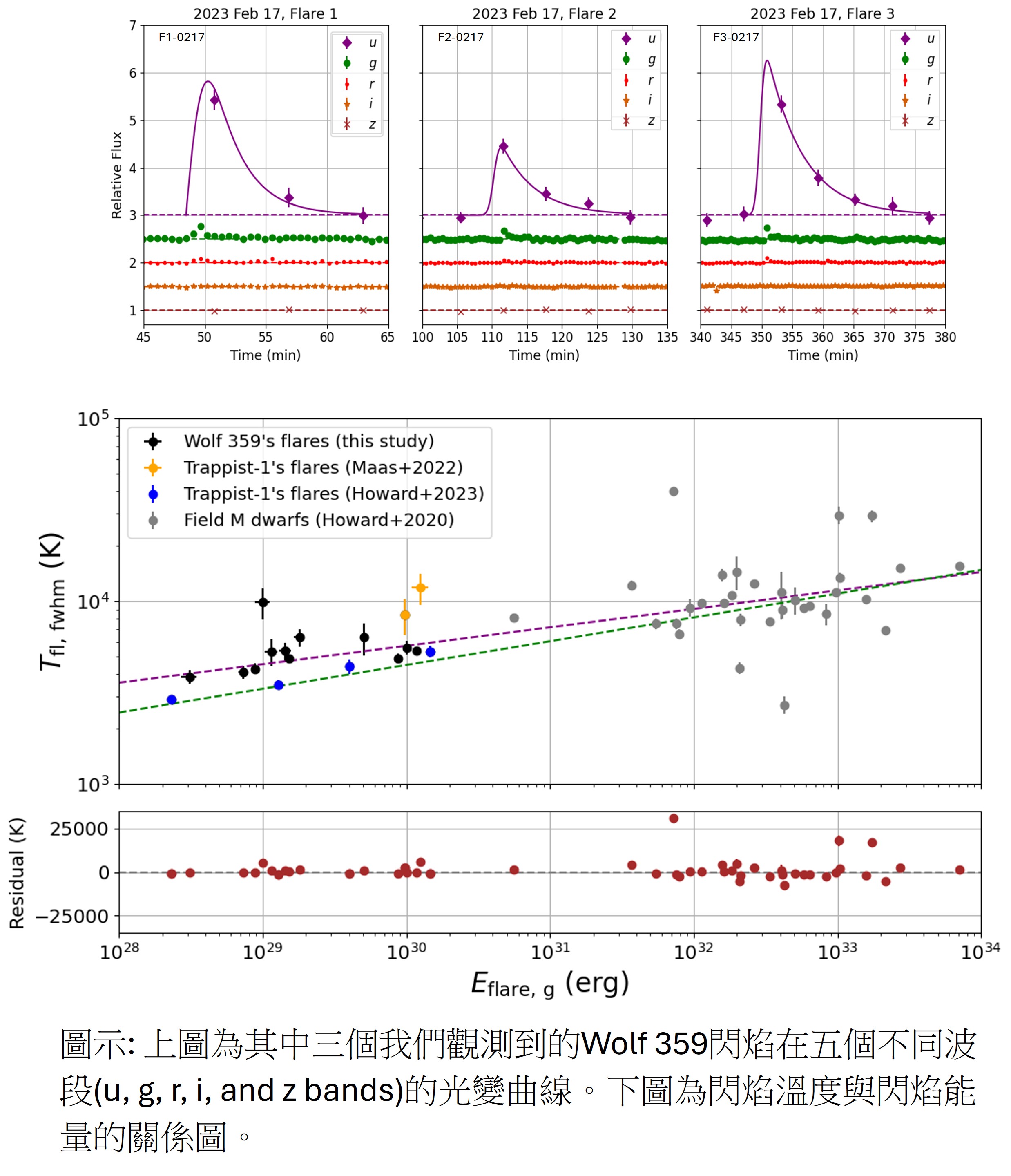 | Dr. Chia-Lung Lin:
We present a flare temperature study of the active M dwarf Wolf 359 using simultaneous multiband (u, g, r, i, z) photometry from the Lulin 1-m and 41-cm telescopes. Twelve solar-class flares (E < 1032 erg) were detected over five nights, with strong enhancements in the u, g, and r bands; only three appeared in i, and none in z. From SED fitting and g/r color ratios, we derive an average flare temperature of 5500 ± 1600 K, cooler than the canonical 10000 K. A power-law relation between flare temperature and energy, consistent with M-dwarf superflare trends, suggests a common temperature–energy scaling. Increased scatter at higher energies implies more complex physics beyond simple blackbody models. Using this relation and the flare energy-frequency distribution, we estimate the contribution to photosynthetically active radiation (PAR) on an Earth-analog, finding that even extreme superflares (≈1036 erg, ≈ 16500 K) cannot sustain an Earth-like level of photosynthetic O2 production.
These results are published in Lin et al. (2025), AJ, 170, 297 (including Prof. Wing-Huen Ip, Dr. Huang Li-Ching, Wei-Jie Hou, and Hsiang-Yao Hsiao). https://iopscience.iop.org/article/10.3847/1538-3881/ae0c0a/meta
Show large images and more information |
 | A study led by the NCU Transient Group investigates a mysterious class of white dwarf explosions known as “Super-Chandrasekhar explosions (or 03fg-like SNe Ia) and reveals their extraordinary ultraviolet (UV) properties. Compared to normal SNe Ia, these events exhibit significantly brighter and broader light curves, along with distinct spectral features. For the first time, the NCU team construct a sample of UV spectra obtained with the Swift satellite and find that 03fg-like SNe show a pronounced UV excess, which is challenging to explain with current explosion models for normal SNe Ia. Our analysis suggests that interaction with circumstellar material (CSM) could provide a promising explanation for their unique UV characteristics. This work has been published as
Bhattacharjee & Pan et al., 2025, MNRAS, 542, 2752.
Show large images and more information |
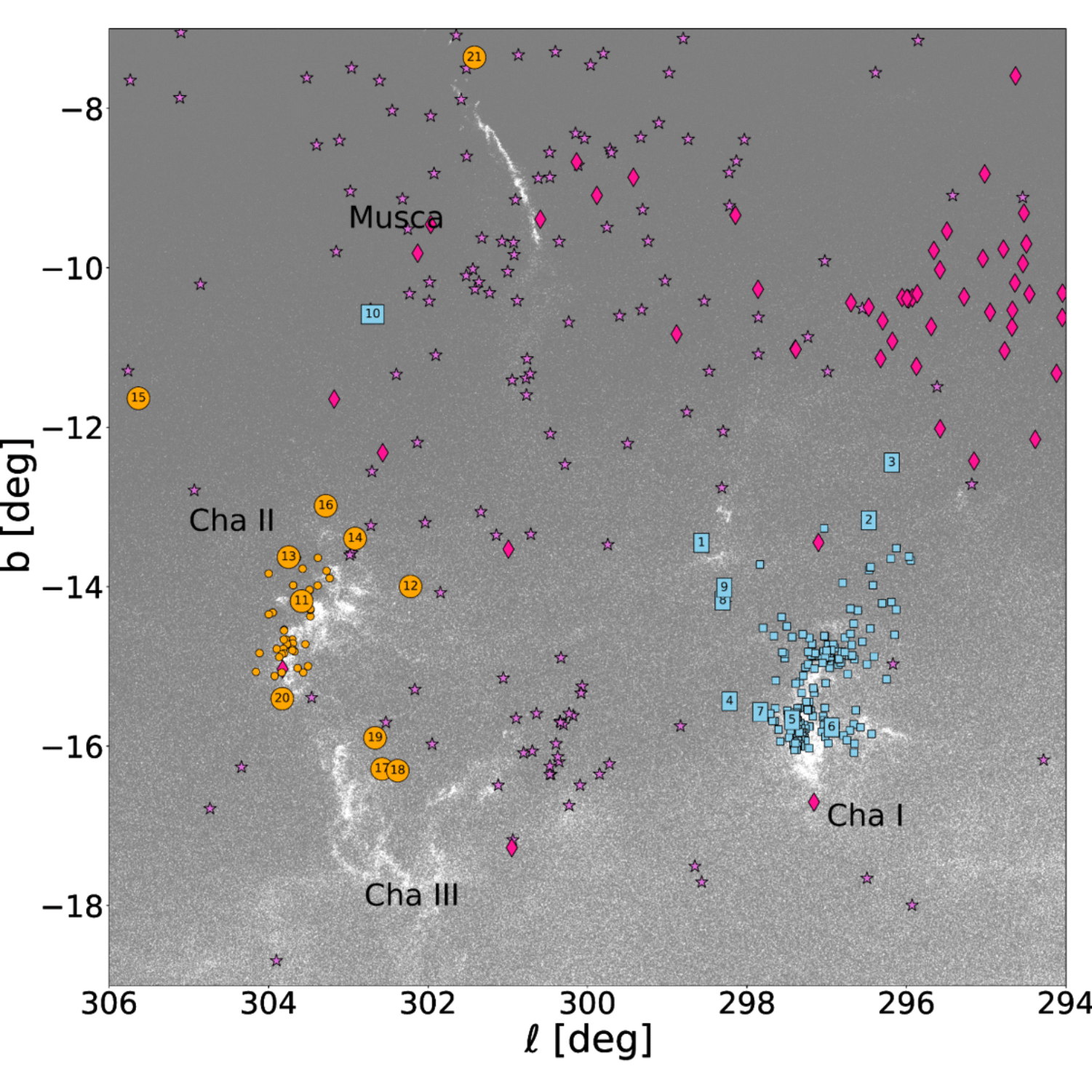 | 圖:蝘蜓座 (Chamaeleon) 周圍分子暗雲以及相關的年輕恆星。圖中每個灰點代表一顆Gaia DR3的星球,用來襯托分子雲的分布。符號代表不同的年輕恆星族群:藍色與一號雲 (Cha I) 相關,橘色則屬於二號雲 (Cha II)。我們驗證三號雲 (Cha III) 沒有恆星形成活動,但驗證有三顆屬於二號雲的成員,投影在 Cha III前方,另外位於西南方的兩個分子雲 Cha East I and II (未顯示在圖中)也沒有年輕恆星。在雲氣之外,有一些之前不知道的年輕星體,以及屬於其他星團(紅色),或位於西北方向(未顯示在圖中)、鄰近的OB星協(紫色),雖然投影在相同天空區域,但分析它們的距離以及運動可以明顯區分出來。有編號的星星是我們新確認的年輕成員。這項研究是陳湘喻碩士論文的一部份,結果發表在 New Astronomy, 2025, 120, 102421
恆星從星際雲氣中成群誕生,有時受到大質量恆星影響,誘發新一代的恆星形成。碩士生陳湘喻跟指導教授陳文屏指認蝘蜓座分子暗雲區的年輕恆星,研究它們的空間分布、與雲氣以及與鄰近大質量恆星的關係,探討此區域恆星形成的過程。我們利用 Gaia 數據找出距離以及運動一致的星體,然後以紅外波段的2MASS 與 WISE資料診斷周圍是否有初生恆星特有的塵埃。這個區域有三個主要分子雲,其中已知 Cha I 恆星形成最活躍,其次是 Cha II,而 Cha III 則沒有任何年輕恆星。之前研究侷限於雲氣濃密之處,而我們使用全天數據,得以指認雲氣以外的成員星,用以解讀恆星誕生與雲氣消散的歷史,並詳細分辨出投影在在同樣天區,但屬於不同雲氣(距離、年齡稍異),以及不同星團,甚至鄰近OB星協的年輕成員(距離、年齡完全不同)。研究結果顯示大質量恆星的恆星風及輻射影響了此區域的雲氣結構(包括北方的 Musca 絲狀暗雲)以及恆星誕生的過程,但整個誘發過程止於 Cha III 之前,並未繼續往南方擴展。
點此看大圖及更多資訊 |
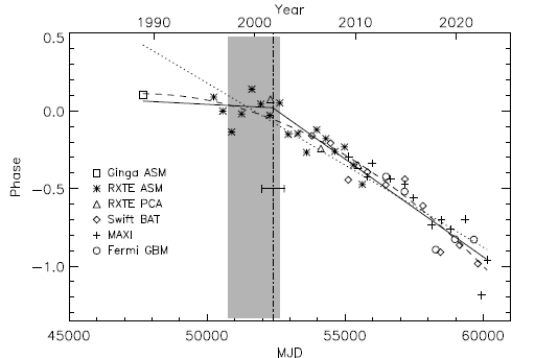 | Caption: Evolution of 4U 1820-30 superorbital phases from 1987 to 2023. The dotted, solid and dashed lines represent the best fits for linear, glitch and quadratic models, respectively. The shaded area indicates the low power state between MJD 50,773 and 52,627, and the vertical dash-dot line represents the period glitch time MJD 52,380±4145, evaluated by the glitch model, with the horizontal error bar indicating the 1σ uncertainty of the glitch time.
Master student Jun-Lei Wu and Prof. Yi Chou studied the superorbital modulation of low mass X-ray binary 4U 1820-30.It was long believed by the astronomers that the superorbital modulation of the low-mass X-ray binary 4U 1820-30, with a period of 171 days, was a resonance effect induced by a third star orbiting the binary system—an explanation known as the triple model. The stability of this superorbital period predicted by this model is crucial for verifying this hypothesis. A research team led by Prof. Yi Chou analyzed X-ray light curves collected by six monitoring and scanning telescopes over a span of 36 years. They discovered that the superorbital period had significantly changed from 171 days to 167 days during this time. Further phase analysis revealed that this change either occurred abruptly between early 2001 and mid-2003 or evolved gradually with a period derivative of Ṗ=(-4.20±0.72)x10-4 day/day. Their findings indicate that the superorbital period of 4U 1820-30 is not as stable as predicted by the triple model, strongly challenging this hypothesis. Instead, they propose an irradiation-induced mass transfer instability scenario to explain the observed superorbital modulation. The research paper has been published in the Astrophysical Journal (
Yi Chou et al. 2025 ApJ 981 43
). Its preprint, posted on arXiv in September 2024, was reported on the renowned public outreach website Phys.org under the title
"Study Inspects Unusual Behavior of an X-ray Binary"
.
Show large images and more information
|
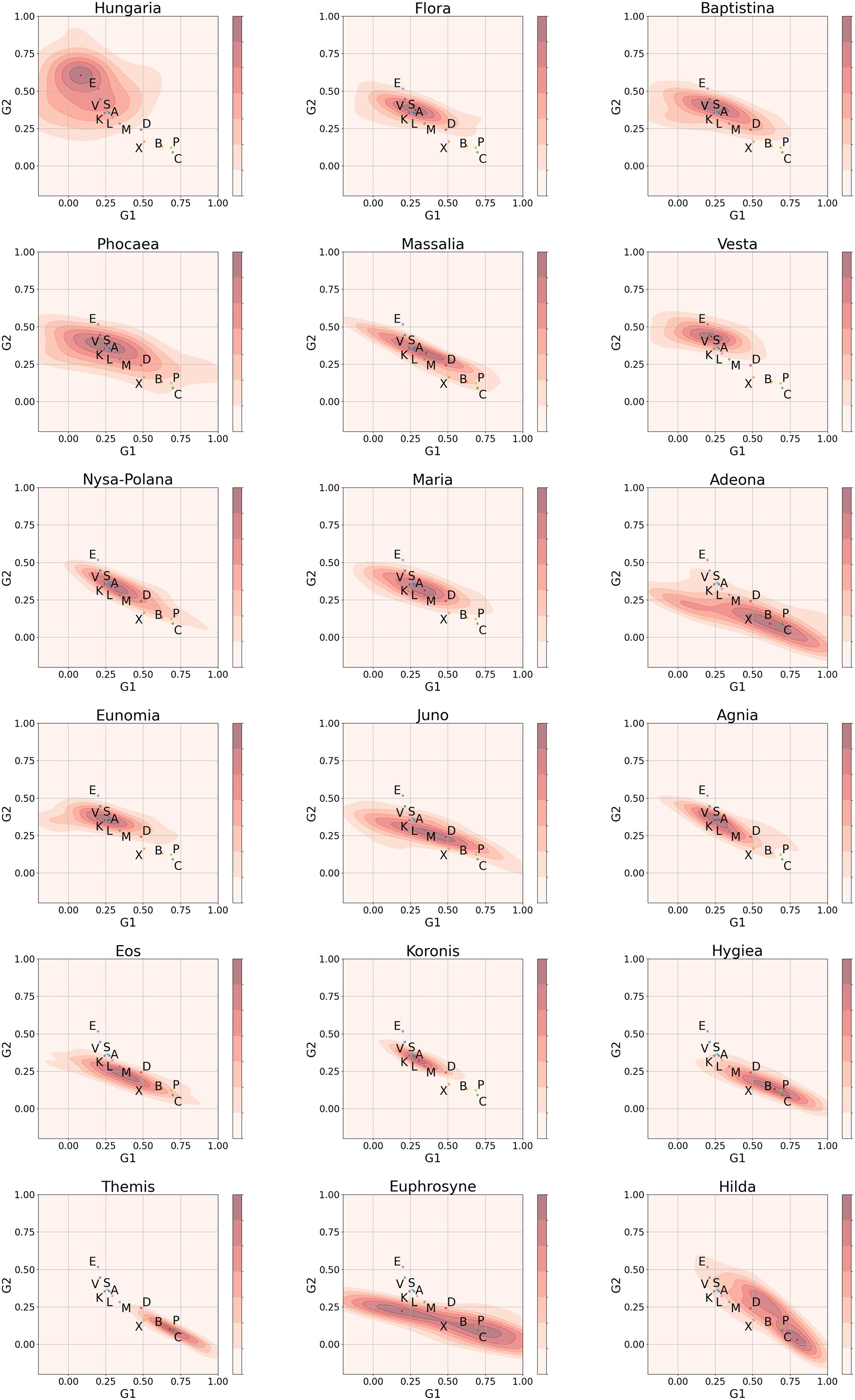 | 圖: 小行星各家族 (Hungaria, Flora, Baptistina, Phocaea, Massalia, Vesta, Nysa-Polana, Maria, Adeona, Eunomia, Juno, Agnoa, Eos, Koronis, Hygiea, Themis, Euphrosyne, and Hilda families)的相位曲線在HG1G2模型中的分佈情形
小行星的分類與大小不再局限於多色測光與光譜觀測
小行星是圍繞太陽運動的岩石或者金屬天體,它們是太陽系形成早期未能發生吸積的殘留物質,因此仍然保存著太陽系原始星雲的信息。 S型和C型是最常見的小行星類型,分別代表了小行星兩種不同的光譜特徵,與它們的物質成分相關。1984年Tholen使用色測光數據將小行星進一步分類,隨後可見光與紅外波段的光譜將小行的分類更加細分,然而小行星光譜觀測與大樣本多色測光數據耗費大量觀測資源,因此尋找替代小行星光譜的分類方法便成為科學家近年來的主要目標。近年來各研究機構陸續使用大型望遠鏡展開巡天計畫,這些巡天計畫往往為了巡天效率多使用單一濾鏡或者少數濾鏡來節省巡天時間,這縮短的時間對瞬變天體很有時效性,但對區分小行星類型是無助益的,因為無法使用多色測光數據得到小行星的色指數,進一步對 多個色指數開展主成分分析!
林忠義博士利用Zwicky Transient Facility(ZTF)(位於加利福尼亞州帕洛馬山的施密特望遠鏡擁有觀測視野達到47平方度)巡天資料將小行星進行光譜分類,論文研究方法為使用單一顏色濾鏡(雖然ZTF有三種濾鏡,但仍以r’觀測資料為最多)求得小行星光度隨相位角之間的關係,也稱之為小行星的相位函數,並將其分類。最後是用分類結果將小行星大小算出,隨後比較各小行星家族的大小分佈函數(size distribution),了解各家族形成的時間與關聯性。這些研究成果已於今(2025)年6月20日發表於國際期刊《皇家天文學會月報》(Monthly Notices of the Royal Astronomical Society)。
點此看大圖及更多資訊 |
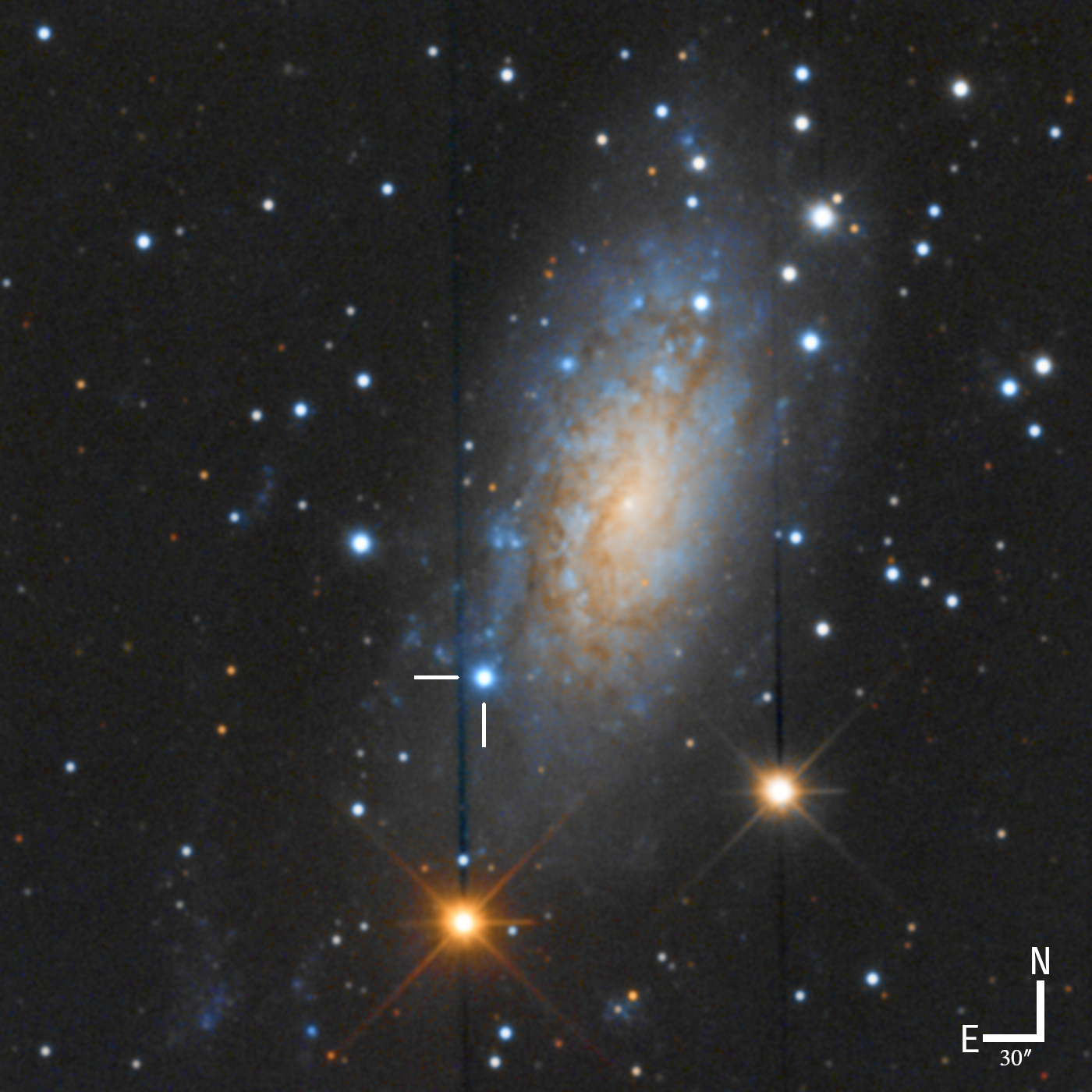 | 圖: SLT三色合成影像SN 2024ggi與其宿主星系NGC 3621。
由陳婷琬教授主持的Kinder計畫,透過鹿林天文台40公分SLT望遠鏡,在SN 2024ggi爆炸後僅14小時即成功取得其極早期的光度與溫度演化資料。SN 2024ggi 位於星系 NGC 3621,由大稀奇天體實驗室參與的ATLAS 計畫所發現,是近十年來距離地球最近的核心塌縮超新星之一(約 6.6 Mpc)。本研究特別結合了來自臺灣與香港的公民天文學家之力量,透過他們提供的光度觀測與鹿林SLT的早期觀測相互補強,提高時間解析度,使研究團隊得以重建SN 2024ggi爆炸初期的完整光變曲線。另外,這也是鹿林天文台首次實現「超新星夢幻連動觀測」:LOT負責光譜,SLT觀測光度!觀測顯示該超新星在早期階段光度迅速上升、顏色轉藍,並伴隨窄發射譜線,顯示其爆炸受到周圍環星物質的顯著影響。研究團隊推測,其前身星為紅超巨星,在爆炸前每年流失約10⁻³個太陽質量,並被約0.4個太陽質量的環星物質所包圍。本成果已發表於《The Astrophysical Journal》(Chen et al. 2025, ApJ, 983, 86)。
點此看大圖及更多資訊 |
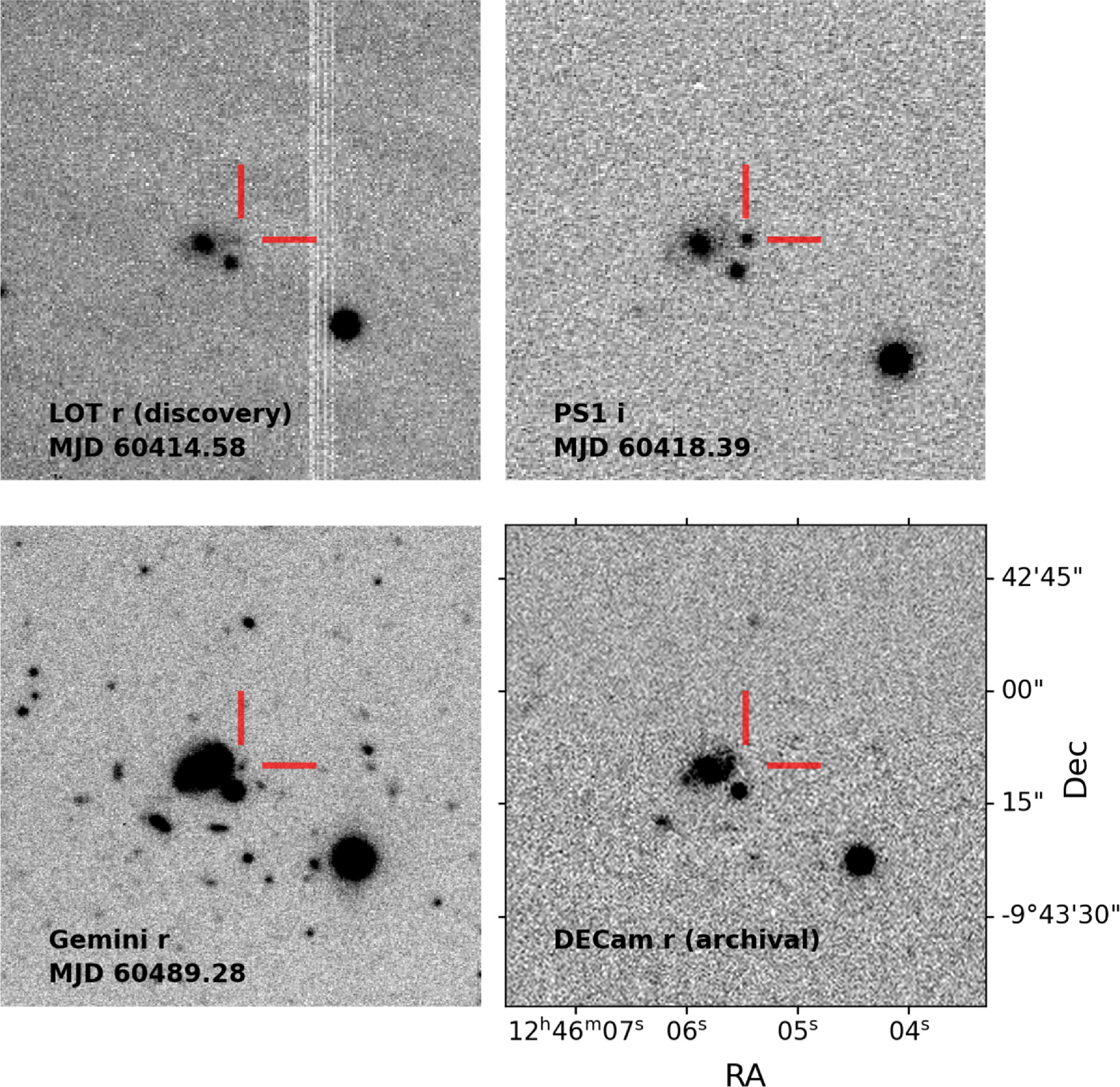 | 圖:AT 2024gsa的LOT發現影像(左上),以及後續由Pan-STARRS1(右上)與Gemini望遠鏡(左下)取得的追蹤觀測影像。同時右下角顯示的是來自DECam的歷史影像。
由陳婷琬助理教授主持的Kinder計畫,使用鹿林天文台一米望遠鏡(LOT)偵測到天關衛星EP240414a事件的光學對應體 AT 2024gsa,並且通報給天文社群。這是天關衛星所發現的第二個具光學對應體的快速X射線瞬變源。該源位於其可能宿主星系(紅移 z ≈ 0.4)外圍,投影距離約27千秒差距。AT 2024gsa 的可見光光變曲線顯示出三個明顯的演化階段。第一階段為自初次觀測起的快速光度衰減,鹿林的早期觀測成功捕捉到這段變化,其光度演化與伽瑪射線暴(Gamma-Ray Bursts)餘輝模型相符。第二階段則是一次再增亮事件,約在兩日(已校正紅移後的時間)內急遽增亮至絕對星等Mr ≈ −21。儘管其明亮亮度與衰減速率類似於高亮度快速藍色光學瞬變(Fast Blue Optical Transients),但AT 2024gsa的色溫卻顯著偏紅,且其峰值亮度與熱輻射模型不符,暗示其並非高亮度快速藍色光學瞬變。第三階段則在快速X射線瞬變源事件發生後約16天達到另一個光度高峰,絕對星等Mi ≈ -19,可能與一顆逐漸顯現的超新星有關。
綜合EP240414a與歷來所有具有紅移資訊的快速X射線瞬變源事件,我們提出:天關衛星所發現的這類快速X射線瞬變源很可能主要來自高紅移的伽瑪射線暴,與早期所知的低紅移、低光度快速X射線瞬變源族群在起源與性質上有明顯差異。本成果已發表於《The Astrophysical Journal Letters》(Srivastav, Chen, Gillanders三位共同第一作者, 2025, ApJL, 978, L21)。
點此看大圖及更多資訊 |







